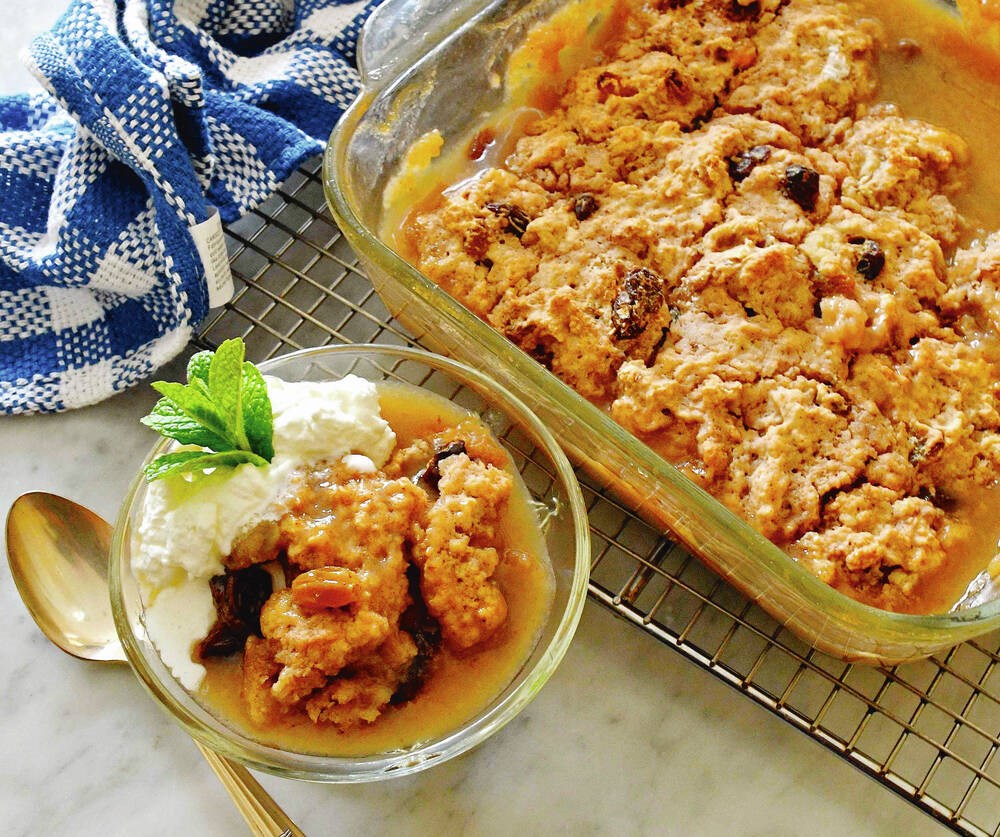
This old-fashioned, sweet comfort food yields a cake-like dessert surrounded by a pudding/caramel-like sauce.
A reader, Ginny, sent me an email and said a group of friends and her were recently chatting about childhood memories of food. Foods their mothers, grandmothers, relatives served that they so fondly remember.
Ginny told her friends about a dessert her mom made called half-hour pudding and none were familiar with it. She added that her mom died a long while ago and that she got to thinking about the origin of the recipe.
“I do not know if it came from her childhood on a prairie farm or if it was a depression [era] recipe. I have had no luck Goggling the origin other than it seems to be a prairie dish, so I now turn to you,” Ginny wrote in her email to me.
I told Ginny I would see what I could find out about the dessert.
If you’ve never heard of it, to make half-hour pudding, depending on the recipe, you either pour a hot water/brown sugar mixture over a batter that been placed in a baking dish, or you put the hot water/brown sugar mixture in the baking dish and top it with the batter. The pudding is then baked for — you guessed it — half an hour.
Like Ginny, I initially did not did have much success finding information about its origin.
Except that many recipes I found for it were often called mom’s half-hour pudding with some believing it dated back to 1940s.
But I eventually found a clue to its possible origin when I found recipes for half-hour pudding also being called Montreal pudding. And when researching Montreal pudding, it lead me to another name for this style of dessert that’s considered a classic Quebec dish, pouding chômeur. In English that translates to “poor man’s pudding” or “pudding of the unemployed.”
Some culinary sources say the late Georgette Falardeau, wife of Camillien Houde, a former mayor of Montreal, created this dessert in the 1930s at the beginning of the Great Depression. Lore suggests that at that time an empathetic Falardeau wanted to bring something sweet to bolster the spirits of the poor and unemployed. Another source, The Canadian Encyclopedia, counters that by saying the pudding was created by Quebec factory workers during the Great Depression, by women trying to make do with fewer ingredients.
Pouding chômeur became a popular dessert all over Quebec and how it was made varied from region to region. For example, in rural places where maple syrup was more readily available, it was used instead of brown sugar.
Eventually, pouding chômeur was no longer associated with poverty and versions of it were made in other parts of Canada. Whether called pouding chômeur, Montreal pudding or half hour pudding, you end up with a dish that’s basically two desserts in one — a cake with a pudding/caramel-like sauce around it.
Below is an adapted version of the old recipe Ginny sent me for half-hour pudding.
Half-Hour Pudding
This old-fashioned, sweet comfort food yields a cake-like dessert surrounded by a pudding/caramel-like sauce. For added richness, if desired, you could top servings of the pudding with whipped cream or vanilla ice cream.
Preparation time: 15 minutes
Cooking time: 30 minutes
Makes: six to eight servings
For the batter
1 cup all-purpose flour
1 cup raisins
1 Tbsp baking powder
1/3 cup packed golden brown sugar
1/2 tsp ground cinnamon
1/4 tsp nutmeg
1/2 cup milk
For brown sugar mixture
2 cups boiling water
1 cup packed golden brown sugar
1 Tbsp butter, plus some soft butter for greasing
Preheat oven 350 F. Grease an eight-inch square baking dish with butter.
Combine the flour, raisins, baking powder, 1/3 cup brown sugar, cinnamon and nutmeg in a bowl. Now mix in the milk, creating a batter.
Combine boiling water, 1 cup brown sugar and 1 Tbsp butter in a second bowl, and then pour into the baking dish.
Drop heaping tablespoon amounts of the batter into the liquid in this dish, ensuring it’s well distributed. Bake pudding 30 minutes, until bubbly and batter is set on top. Serve the pudding hot, warm or at room temperature.
Eric Akis is the author of eight cookbooks. His columns appear in the Life section Wednesday and Sunday.








